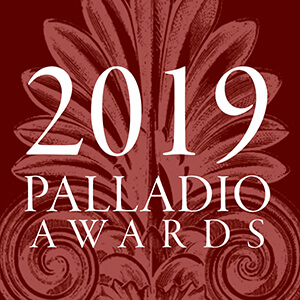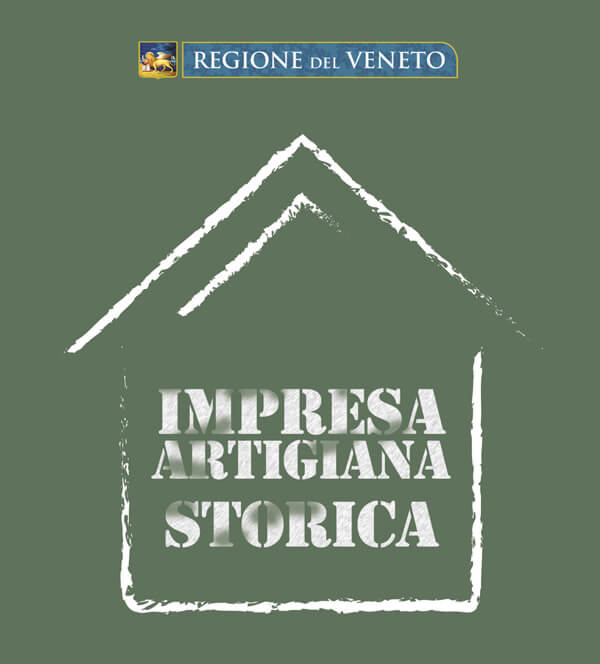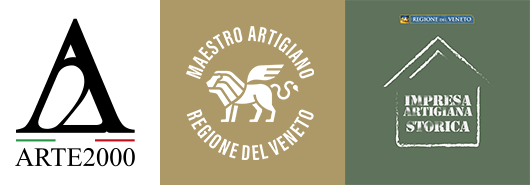

Territory
Our workshop is situated in Colle Umberto, a small town in the countryside of the Marca Trevigiana in Veneto. The name “Colle” originated from the location of the medieval settlement perched on the main hill and “Umberto” was added in 1867 after the visit of Prince Umberto I, future King of Italy. We are in a very rich territory of history, art, culture, nature, typical products, famous wines and traditional dishes, with suggestive and famous destinations easily reachable.
For lovers of art, architecture and history
Venetian villas, castles and medieval villages
In Colle Umberto there are:
- Villa Morosini Lucheschi Valforte is in a position of landscape relief and is a cultural and architectural reference point;
- Villa Verecondi Scortecci is in the village of Poggio; in the park of oaks and cypresses there is a church dedicated to the Madonna della Salute.
About ten kilometers from our workshop, in the city of Conegliano, there are:

Conegliano in Treviso. Picture of the Association Walled Towns of Veneto
- Villa Gera is a majestic residence in Palladian style situated in Colle of Giano near the Castle, inside the ancient walls. It was designed by Giuseppe Jappelli: an Italian engineer and architect, well known as designer of romantic gardens;
- the Castle of Conegliano is located on the top of the Colle of Giano, in a strategic place to dominate the whole city and the surrounding territory in medieval times;
- in the historical center there is the house-museum of Giovanni Battista Cima where the illustrious painter lived
The Castle of San Salvatore is on top of a beautiful hill in Susegana near Conegliano. It dates back to the end of the thirteenth century and has always belonged to the Counts of Collalto who are still the owners of the homonymous farm, one of the oldest in Italy, where wines of excellence are produced using grapes from private vineyards.
In the province of Treviso there are many other Venetian villas, some are UNESCO World Heritage; here you can find a selection of 10 charming and famous villas.
The Castle of Zumelle in Borgo Valbelluna, about seventy kilometers from Colle Umberto, is in an enchanting and suggestive position. It stands on a hill overlooking the Terche torrent and probably was built by the Romans in the first century A.D. in order to control the passages on the Via Claudia Augusta Altinate.
Antonio Canova Museum
The Museum of Antonio Canova, sculptor absolute protagonist of neoclassical art, is in Possagno, a small town at the foot of Monte Grappa about fifty kilometers from Arte 2000. It is a unique point of reference to know the sculptor, appreciate his works and the inestimable historical and artistic legacy that has left us. His brother Giovanni Battista Sartori transferred to Possagno all the drawings, sketches and plaster models, created to realize the original marble works now exhibited in the most important museum collections in the world, which had remained in his Roman studio after his death.
The Museum includes:
- the Gypsotheca
- the birthplace
- the library
Unfortunately, many plaster casts were damaged by bombing during the First World War; the building was then restored and set up with the contribution of the architect Carlo Scarpa. In the upper part of the village there is the unique Canovian temple designed by Canova to enhance the greatness of the three civilizations of art: Christian, Roman and Greek. It was concluded after his death; from 1832 it became parish church of Possagno.
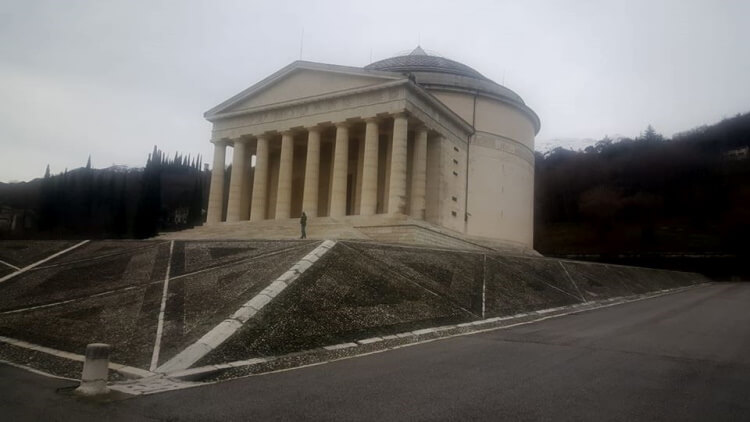
Canovian temple in Possagno. Picture of Paola Pin
Itineraries of the Great War
The Veneto region was the scene of the greatest battles of the Great War, between the Italian army and the Austro-Hungarian, in the years 1915-1918. Even today you can see ambushes in the high mountains, trenches and military posts up to the mouth of the Piave, known as “The sacred river of the homeland” because it was the most backward defense frontline where the Italian army blocked the enemy offensive. At about sixty kilometers, on the top of Monte Grappa, you can visit one of the main military ossuaries.
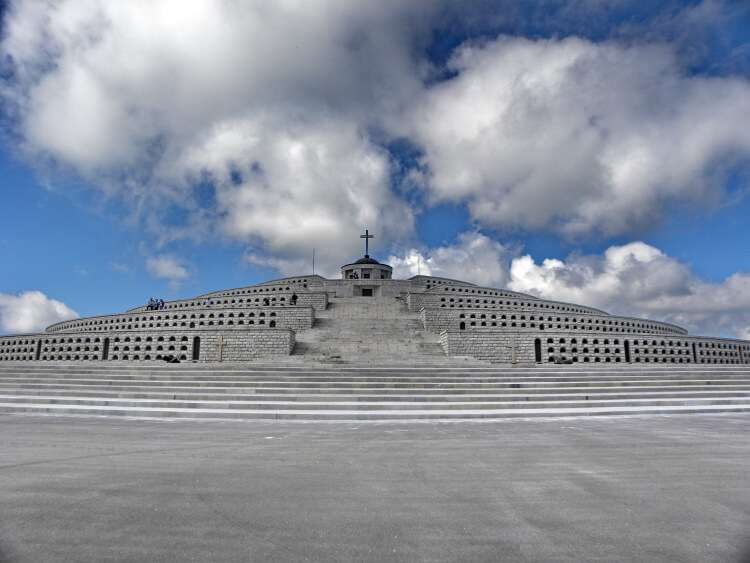
Monte Grappa military shrine
Visiting the places that belonged to the Dominions of the Venetian Republic you can admire many sculptures and stone bas-reliefs depicting the Lion of San Marco, a secular symbol of the Venetian Republic and today of the Veneto Region. In the historic villas, gardens and palaces there are some of our recent works.
Two world famous destinations
Venice is a city of art unique in the world

Venice. Picture of Ottavio Marcuta
It is a must for its unique charm with a historical, artistic and architectural heritage that tells centuries of history; it is located about sixty kilometers from our workshop. It was built on the lagoon between beautiful islands and canals, most of the structural, architectural and artistic works are in Istrian stone. The calli, the so-called “campi” squares, the famous monuments, the bridges, the museums, the churches and the historical palaces are rich of Renaissance treasures. Among the many islands the most important and touristic ones are Burano, Murano and Torcello: famous for the working of the glass, the lace and the coloured houses.
Cortina d’Ampezzo is an iconic town
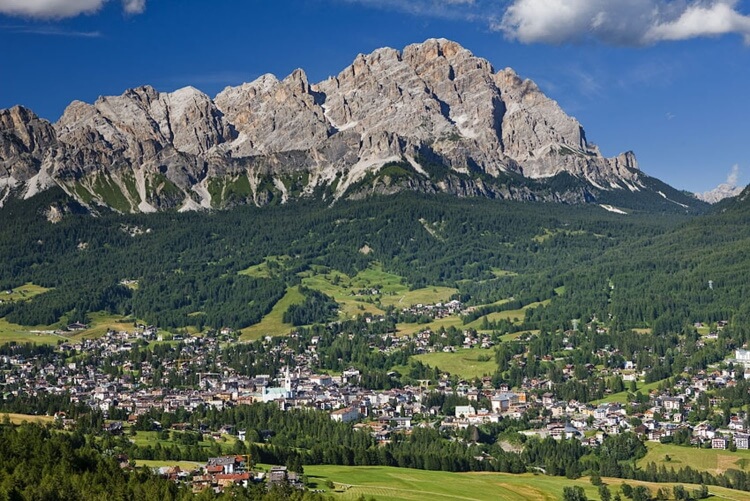
Cortina d’Ampezzo – Dolomites
It is one of the most famous mountain resorts in the world. It is located in the heart of the Dolomites, in the province of Belluno, less than a hundred kilometers from Arte 2000, and is nicknamed “Queen of the Dolomites”. It hosts many international events related to the mountains and winter sports, in 2026 it will even host the Winter Olympic Games. It is surrounded by beautiful scenery and extraordinary landscapes; in fact it is a renowned winter and summer tourist center very popular among famous people.
For fans of food and wine
You can immerse yourself in the green of beautiful hills and relaxing countryside to admire natural landscapes full of charm, taste excellent wines and eat high quality products linked to the Venetian culture, history and past.
The Prosecco Hills of Conegliano and Valdobbiadene, UNESCO World Heritage
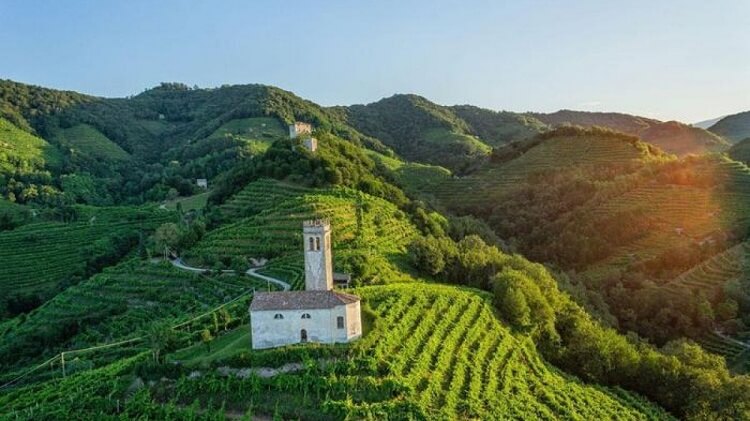
Prosecco hills of Conegliano and Valdobbiadene – Unesco
They are located in an area where the famous wine Prosecco of Conegliano-Valdobbiadene DOCG (Denomination of Controlled and Guaranteed Origin) is cultivated and produced.
It is a difficult natural environment, with steep slopes, where in the past centuries man conquered the soil little by little in order to adapt it to the cultivation of the vine. The landscape is characterized by small vineyards on narrow grassy terraces, called ciglioni, woods, hedges, unproductive fields and ancient villages that make the environment very charming and fascinating. They extend from Vittorio Veneto, near Colle Umberto, to Valdobbiadene. They are crossed by the historic Italian wine road “La Strada del Prosecco” along which it is possible to taste prestigious wines in wineries and typical taverns. The route starts from Conegliano, where there is the oldest wine school in Italy, the famous Cerletti Institute, and ends in Valdobbiadene. In the surrounding countryside there are many other renowned DOCG wines, such as those of Colli of Conegliano, Colli Asolani and Torchiato of Fregona.
Tastes, flavors and typical products PDO and PGI
In the Marca Trevigiana there is a wide variety of rustic, refined, familiar and elegant environments where you can taste traditional dishes. For lovers of good food, there are some products of ancient origin very appreciated and protected by the European brands D.O.P. (Protected Designation of Origin) or I.G.P. (Protected Geographic Indication), such as:
- the Casatella Trevigiana cheese
- the Marrone of Combai chestnut
- the white asparagus of Cimadolmo and the asparagus of Badoere, cultivated along the plains that lines the Piave where there is also the Asparagus Road
- the red radicchio of Treviso
- the radicchio variegato of Castelfranco
For lovers of nature
Dolomites: a fantastic UNESCO World Heritage
Cover photo: Three Peaks of Lavaredo – Dolomites
The Dolomites are a group of imposing Italian mountains known all over the world for their extraordinary landscape and natural value. They extend mainly in Veneto, but in part also in Trentino Alto Adige and Friuli Venezia Giulia. They start about fifty kilometers from our workshop and offer unforgettable landscapes full of charm with woods, forests and rocky peaks of extreme beauty that exceed 3000 meters of altitude.They include many nature parks and the largest Italian ski area “Dolomites Superski”. Eternal glaciers, snowfields, springs, spectacular waterfalls, pure lakes and streams that sometimes flow in deep gorges that characterize every mountain. Near the enchanted peaks, extraordinary mountain refuges, reachable only on foot, allow you to immerse yourself in the silence and peace of pure nature. They are appreciated by athletes in all seasons; there are vie ferrate, Alpine and tourist trails, to be covered on foot, on horseback or by bike, snow-covered runs for skiing and snowshoes and panoramic peaks for paragliding enthusiasts.
Grotte of Caglieron and Cansiglio
The Grotte of Caglieron are hidden in the forest in a very suggestive place. They consist of a deep gorge hollowed out by the Caglieron stream and man-made artificial cavities for the extraction of the “piera dolza”: an ancient sandstone used in the past centuries for the construction of local houses. They are located in Breda of Fregona, about 10 kilometres from our workshop. Continuing uphill along the main road, at 1000 meters above sea level, we meet the Cansiglio upland: an enchanting, pure and very wide place, surrounded by the homonymous beech forest and rocky peaks, near the provinces of Treviso, Belluno and Pordenone.There are many hiking trails, but you have to pay attention to the structures of karstic origin, sometimes hidden, such as gorges and sinkholes, among which the best known is the “Bus de la Lum”. Until 1797 it was owned by the Serenissima which used the wood for the production of oars and coal. On the plain there is the Golf Club Cansiglio, the second most important golf course in Veneto and one of the best mountain trails in Europe.
Lakes: stretches of water among the mountains
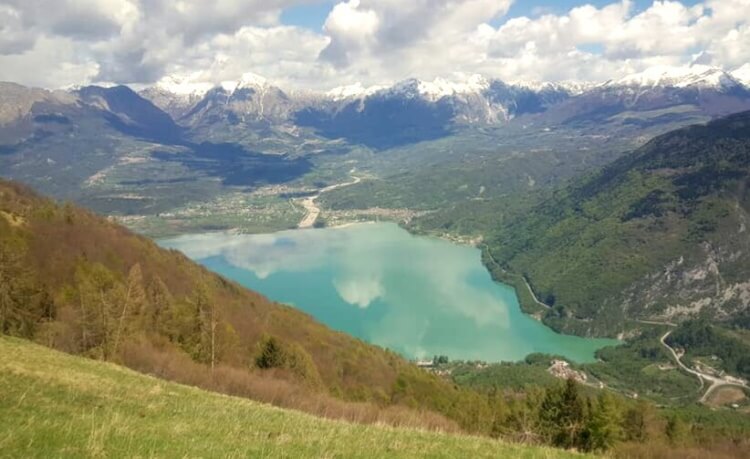
Santa Croce Lake in Alpago – Belluno. Photo of Paola Pin
The Lakes of Revine are two beautiful lakes of glacial origin at the foot of the Prealps, among the green hills of Treviso, villages and woods. The village of Revine, not far from our workshop, is a stop on the famous Munich-Venice route.
Along the road to Belluno we meet three Lakes of Val Lapisina: Negrisiola, Restello or San Floriano and Morto, the latter has a tourist loop route along the shore and in summer is always full of bathers. They are stretches of water immersed in the forest where the peaks above are reflected. It is said that the famous painter Tiziano Vecellio, in the painting Amor sacro e Amor profano, got his inspiration from the landscape of Val Lapisina where he lived for some years. After some kilometers, we find Lake Santa Croce which is the largest natural lake in the province of Belluno and the second regional stretch of water after Garda Lake. It’s in the Alpago area 30 kilometers from our workshop. It is one of the most windy lakes where strong air currents very loved by windsurfing, kitesurfing and sailing enthusiasts from all over Europe. Along the shore there are campsites and beaches with all the tourist facilities.
Regional Natural Park of the Sile river
It is an extraordinary natural environment, about forty kilometers from Colle Umberto, which can be visited thanks to the “Girasile” route for slow mobility on foot, by bike or by boat. The Sile River is the longest spring river in Europe. The walk along the Sile can be an opportunity to visit the walled city of Treviso that reminds Venice for the presence of bridges and canals.
Our territory is a place to discover, live and enjoy!
